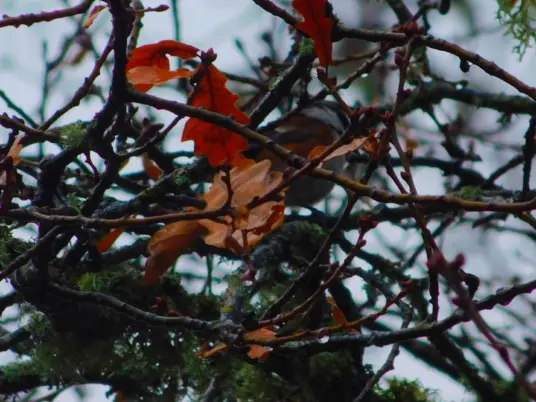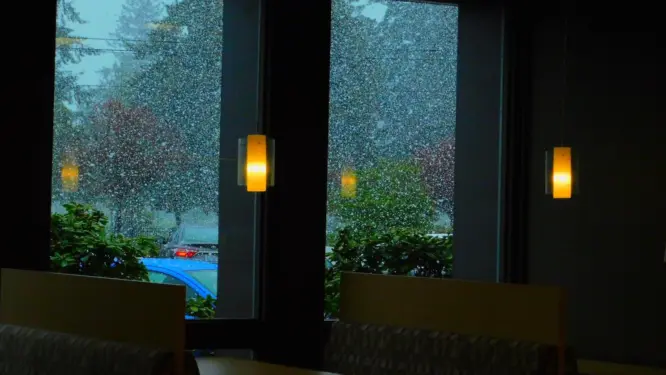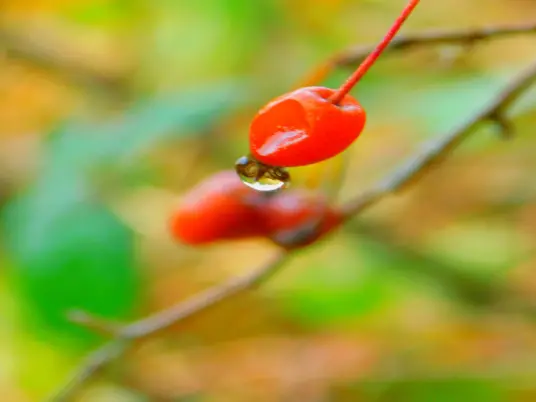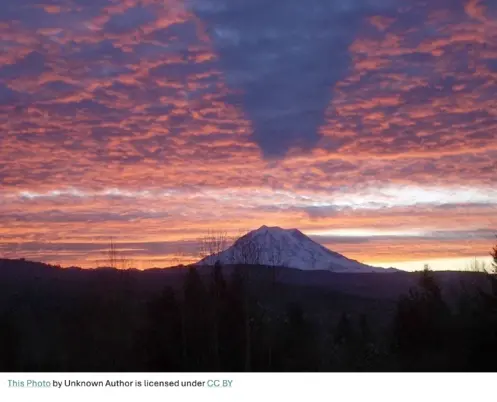Wending Wintry Words
by Marcia Wilson
Winter comes with its own beauty, and there are words for it. For the people on campus who have seen things and thought, “I wonder what that’s all about?” here are some terms.

Marcesent
This time of year, it looks odd to see leaves are still on the trees—and dead ones at that. The Garry Oaks of the CPTC Outdoor Lab are marcescent. Their leaves hang on stubbornly and seemingly without reason.
Luckily, there is a reason. Marcescent trees provide more shelter and food for wintering insects, birds, and animals. In the heavy winter rains, the leaves lessen the impact of water on its way to the ground and offsets potential damages by runoff. Close observation has led scientists to believe the dry leaves also act as blinds or bluffs, hiding the tender growth of spring from the hungry eyes of animals that would eat them down.
Graupel
This is a word more likely to be heard among the Old-Timers of Puget Sound and there are many different ways to spell it. It dates back to a very old Germanic word for “pearl barley” and means the soft, heavy snow fused to supercooled raindroplets. It looks and hits like very cold and soggy oatmeal. In the Southeast it is called “hominy snow”. Graupel was an unexpected if beautiful sight on campus a few times early in the winter of 2023 but it is too soon to tell if there will be a repeat in 2024.

Murmuration
 Photo Marcia Wilson. The “stars” in this young bird’s plumage show how they got their name.
Photo Marcia Wilson. The “stars” in this young bird’s plumage show how they got their name.
Like them or loathe them, starlings are unique to all the other birds in the world. They practice a behavior from fall through winter called murmuration. The word comes from the “murmuring” sound of many wings in flight. The more the merrier, when there can be up to 100,000 starlings, they form fantastical forms that look like gigantic serpents. This is the evolutionary “safety in numbers” trick dialed up to Level 11. The use of murmuration as a collective noun goes back about 500 years. It is returning to “modern talk” because aviation scientists (especially physicists) are studying the mystery of how they can move in such dense groups at high speeds (up to 50mph) without colliding. For that matter, they are still trying to figure out why they’re doing it in the first place.
When humans murmurate, they are speaking so softly they can barely be understood.
Susurration:
Susurration also means murmur, but to the sound trees make when their leaves and branches are moving in the wind. Humans have admired this wild music long enough that a whole branch of music was developed in mimicry thousands of years ago (and not just with wind chimes). The art form, which is as much architecture and mathematics as it is aesthetic, traces back as far as ancient India, China, and Greece. When someone refers to “Aeolian music” they often do not know they are contributing to the tradition. Modern musicians are still trying to explore the possibilities of this art, and examples can be found here and here.
Rainshadow: The complete opposite of Western Washington
“A rain shadow is a patch of land that has become a desert because mountain ranges block much of the rainfall necessary for plant growth.”—National Geographic
Rainshadows are also rich, diverse, and valuable ecosystems adapted to low annual rainfall and warmer weather. Washingtonian Bill Speidel fondly used the word in his oft-quoted book, The Wet Side of the Mountains.
Persistent Fruit

Old-timers call the fruits that linger over winter, “mummies” and warn children to stay away from fruit left on the twig after the first frost. Persistent fruits help to feed Pierce County’s native birds. Landscape designers consider their aesthetic value when they are choosing trees and shrubs for a client. Some, like the quince growing behind Lakewood’s Building 8, are supposed to improve flavor after a frost.
Gnomon
Without a gnomon, there is no sundial. Students on campus are familiar with the sundial by Building 17 (and Dr. Faust’s students are expected to find it for a grade). The gnomon is the part of the instrument that casts the shadow that tells the time. This year, Mt. Rainier demonstrated its use as a gnomon sundial to spectacular effect. While always admired, it is an all-too-brief photo opportunity: the best cast and light happen on cold, late fall to winter mornings at dawn.
Winter Bloom
Flowers that bloom in winter will always get attention. Winter Blooms are the flowers that do this naturally. The heather on campus blooms year round.

